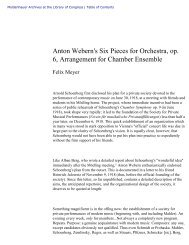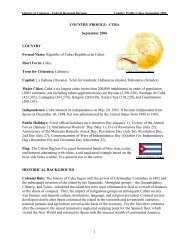1 - American Memory
1 - American Memory
1 - American Memory
Create successful ePaper yourself
Turn your PDF publications into a flip-book with our unique Google optimized e-Paper software.
212<br />
ping interruptions—with the costs of such inventory-holding being<br />
pas^d on to the consumer, of course—there is little he can do to stop<br />
the hoarding that takes place and leaves his shelves bare or depleted.<br />
And it is the merchant who is blamed for failing to meet consumer<br />
needs.<br />
Some coiisumei"s believe higher prices in Hawaii are the result of<br />
profiteering rather than because of a long supply line combined with<br />
heavy inventory requirements because of the ever-present threat of<br />
shipping interruptions.<br />
This IS certainly not the case as State of Hawaii Department of<br />
Taxation data reveals. A summary of this information for calendar<br />
1971 shows that 45.6 percent of all corporations had no taxable net<br />
income, that 25 percent of all proprietorships reported net losses, and<br />
that only 495 of the 8,071 corporations filing returns that year paid<br />
cash dividends. The majority of the 37,600 enterprises filing tax re-<br />
turns for 1971 would have to be classed as marginal operations. Fur-<br />
ther, all of them combined paid the State only $38.4 million in net<br />
income taxes, representing 7 percent of the State's total receipts of<br />
almost $530 million.<br />
Surface shipping interruptions lasting from 2 to 177 days have<br />
occurred 82 times in the past 28 years—an average of three times per<br />
year. Between November 1968 and December 1972, there were 272<br />
days when shipping from the west coast alone was halted—or 18.6 per-<br />
cent of all the calendar days in that period, the equivalent of more<br />
than 5.5 days per month on the average.<br />
Hawaii could certainly adjust to mterruptions of a few days dura-<br />
tion on an occasional basis. However, shutdowns of surface shipping<br />
for periods of 34 days, 41 days, and 100 days on the west coast during<br />
an 18-month period are devastating to the economy and especially to<br />
small firms.<br />
Once such interruptions end, it takes most businesses from 3 to 9<br />
months to get back to normal in terms of both inventory and financial<br />
stability. The backlog of demand cannot be met overnight and the fi-<br />
nancial setbacks are slow to overcome.<br />
Business in Hawaii is currently very much concerned about the sus-<br />
tained high unemployment rate—8 percent statewide in July and as<br />
high as 10.5 percent for Hawaii County. In June the statewide figure<br />
reached 8.4 percent.<br />
We are faced with 14 longshore and seagoing contracts on the west<br />
coast due for expiration in June, 1975. As the accompanying report<br />
published by the Hawaii Employers Council shows, we are also faced<br />
with four east and gnU coasts contracts expiring at that time, plus six<br />
longshore contracts in Hawaii.<br />
Mr, Chairman, we have a fragile economy. Sugar and pineapple<br />
plantations are closing down at a rapid rate and other agricultural<br />
production cannot, for at least 20 years, if then, replace the losses we<br />
are experiencing in these two commodities. Construction is expected to<br />
be lower next year than in any of the past several years. And tourism,<br />
our current major source of income, has grown at a rate of only 6 per-<br />
cent this year compared to annual growth rates ranging from 11.2<br />
percent to 28.8 percent for the past decade. Defense expenditures, our



![Albert Einstein Papers [finding aid]. Library of Congress. [PDF ...](https://img.yumpu.com/21604228/1/190x245/albert-einstein-papers-finding-aid-library-of-congress-pdf-.jpg?quality=85)





![American Colony in Jerusalem Collection [finding aid]. Library of ...](https://img.yumpu.com/17941275/1/190x245/american-colony-in-jerusalem-collection-finding-aid-library-of-.jpg?quality=85)



![Piccard Family Papers [finding aid]. - American Memory - Library of ...](https://img.yumpu.com/17941234/1/190x245/piccard-family-papers-finding-aid-american-memory-library-of-.jpg?quality=85)


